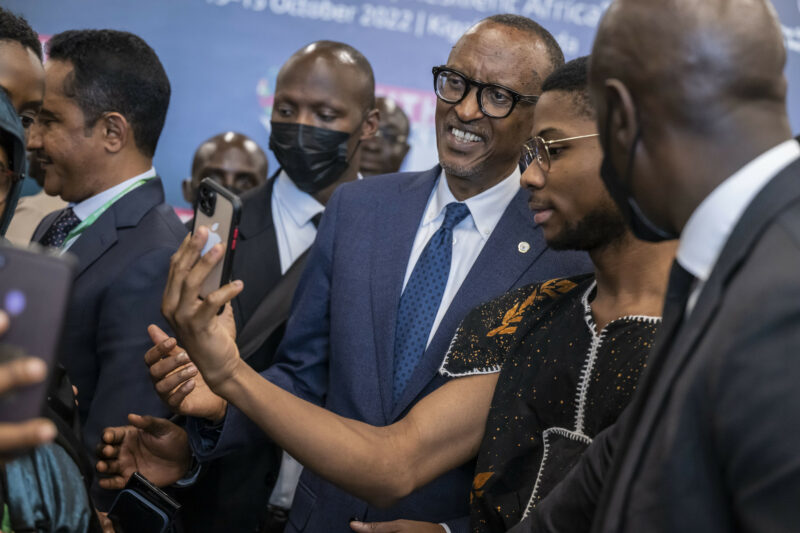
One of the most viewed photos on President Paul Kagame's Flickr account: YouthConnekt 2022 Africa Summit, Kigali, October 13, 2022 (CC BY-NC-ND 2.0).
It's not often that you find the president of a country actively and prominently sharing high-quality professional official photos of all state functions, domestic and international, on a stock photography site. It is even rarer for a president to make photos freely available for non-commercial usage under Creative Commons. That is exactly what Rwandan President Paul Kagame has been doing since he joined Flickr in 2009. Though it's most likely his communications team that executes, the fact that it is his name and face on the platform makes for a good case study on how the continent can reclaim its visual narrative.
Since 2009, President Kagame’s Flickr account has gained 2,600 followers and over 59,000 photos which have been viewed by 119.2 million people so far. All his images are under Creative Commons and have an Attribution-NonCommercial-NoDerivs 2.0 Generic license. This means that one may copy and redistribute the material in any medium or format as long as it's non-commercial, gives appropriate credit, and provides a link to the license.
Some of the most popular photos on the image hosting and community site are of him with other world leaders, such as former U.S. President Barack Obama and former First Lady Michelle Obama, Minister of Foreign Trade and Development in the Kingdom of the Netherlands Lilianne Ploumen, Queen Elizabeth II, and former Arsenal captain Tony Adams. While this is a great PR tool for his presidency, it is becoming a resource for media not just in Rwanda, but also for writers such as myself.
The importance of accessible images
I stumbled on his account as a bit of a fluke. The first time, I was writing a story on Uganda's General Muhoozi's diplomatic gaffes. The second time was while I was recently editing a story on Tanzanian President Samia Suluhu. It has since become my go-to source for any stories I or other GV contributors have written on the East African region.
One of the biggest challenges the work of editors and writers at Global Voices (GV) has been sourcing relevant Creative Commons images that are not only appropriate but also, those that help further tell the particular story. Being a non-profit media organisation, GV fully relies either on images under Creative Commons, those taken by contributors, or those where explicit permission has been sought and granted.
Non-profit entities such as Global Voices (and other media outlets), as well as charities, advocacy groups, educational institutions, government agencies, educators, and individuals often use images under Creative Commons licenses to promote their causes, educate the public, or publish content for blogs and social media.
The argument for Creative Commons among African photographers constantly falls on deaf ears. For most, their images are meant to bring in money for them, as one photographer told me. And that is their most immediate need in a cutthroat market where they often compete with better-equipped and more connected international photographers affiliated with agencies such as AFP, AP, Getty Images, and Reuters.
The danger of a single image
In a TED talk, renowned Nigerian writer Chimamanda Ngozi Adichie, explained what she called “the danger of a single story.” She spoke about how stories can influence identity, shape stereotypes, and build paths to empathy. How about images? What is the danger of a single image?
Tall giraffes striding across lush savannahs or nibbling an acacia plant. Maasai warriors in mid-flight. Emaciated underage children carrying firearms or holding bowls. White tourists on safari with zebras and lions in the background. Mud houses in the middle of nowhere. These are the images that most often appear on search engines when the word “Africa” is typed. They are the same ones (or variations of them) that international media use for their news stories, in which Africa is often misrepresented as a singular monolith whose people are ravaged by starvation yet one whose beauty is breathtaking, rather than 56 states that are diverse and nuanced.
A 2021 report by Africa No Filter found that over-reliance on international news agencies is the main reason why African media outlets continue to perpetuate harmful narratives about Africa. Though the study was on media outlets in the continent, the story is no different for international media. If anything, it's often worse.
Media nowadays rely more heavily on stock photography or news wire agencies than they did before. Driven towards cost-cutting measures because of a drastically changing media landscape, most have either supplemented or completely done away with their own photography. Compared to the cost of retaining staff to cover all required geographical regions plus the ensuing employee benefits or paying the fees for a news wire, stock photography has become the more cost-effective way for media outlets to acquire high-quality images quickly and easily, especially for non-time-sensitive or feature articles. And therein lies the problem.
Stock photography websites and agencies have been guilty of perpetuating these stereotypes. Agencies such as AP, Getty Images, and Reuters have photographers all over the world, for coverage of events or news. By providing free images that show the everyday life of a leader in Africa, the Rwandan president is debunking the stereotypes about the continent and its leaders who are often depicted as incompetent, corrupt, and power-hungry. More importantly, he is reclaiming the visual identity of Rwanda — a country still haunted by the ghosts of the 1994 genocide. For countries similarly grappling with the danger of a single image, Kagame's example is worth emulating.
Wiki loves Africa
When French engineer Florence Devouard and Zimbabwean communications and marketing expert Isla Haddow-Flood launched Wiki Loves Africa in 2014, there was a dearth of images representing Africa on Wikimedia Commons. Since then, this annual public photographic contest where people across Africa contribute media (photographs, video, and audio) about their environment for use on Wikipedia has so far outsourced over 72,000 images.
Compared to the length and breadth of the catalogue for sites such as Getty, it is a drop in the ocean.
As we enter a new AI age with the release of Dall-e and ChatGPT with many more down the pipeline, in what ways can Africans visually train the deep learning models to understand us better? Could having more photos on Creative Commons be a major catalyst?







